The Secrets of Immortality - A Voyage from Greek Mythology to the Immortal Jellyfish
I love to read myths, legends, and folktales because they transport me to another world filled with magic, adventure, and wonder. These stories have been passed down through generations and hold a special charm that captivates my imagination. I enjoy unravelling the intricate narratives and uncovering the moral lessons hidden within them. Often, these tales carry deeper meanings that resonate with universal truths about human nature, society, and the world around us. Reading myths, legends, and folktales allows me to explore different cultures, beliefs, and perspectives, broadening my understanding of the world and enriching my own storytelling abilities.
A Hydra is a mythological creature from Greek and Roman mythology. It is typically depicted as a serpent-like water monster with multiple heads. In some myths, the Hydra is said to have anywhere from five to one hundred heads. One of the most famous stories involving the Hydra is the myth of Hercules and the twelve labours, where Hercules is tasked with killing the Hydra as one of his challenges. However, there is also a real creature having this name. Yes! Hydra is a real genus of small, freshwater animals called cnidarians. They are known for their regenerative abilities and can reproduce asexually through budding. I’ll talk later about this amazing non-fictional creature. First back to the myth…
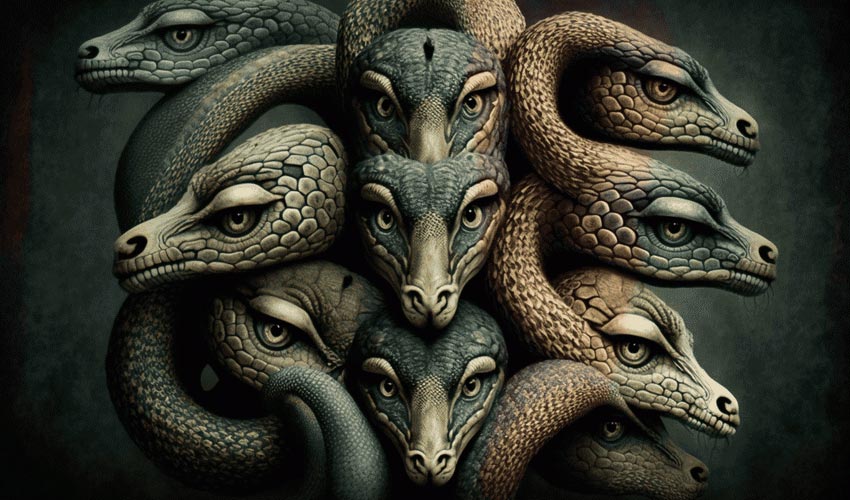
The Mythical Hydra
The journey had been smooth sailing until this moment, with the gentle winds propelling the ship forward at a steady pace. The sun shone brightly in the sky, casting a warm glow over the marshland that surrounded you. But as you looked out at the seemingly endless horizon, a disturbance in the water caught your eye. At first, it was just a small ripple, barely noticeable amidst the calm waves. But then, the water began to churn and bubble, forming into a menacing figure that rose higher and higher until a creature unlike anything you had ever seen emerged from the depths. Three heads, all connected to the same monstrous body, thrashed about in the water, each one snarling and snapping in your direction. Instinctively, you reached for your sword, determined to defend yourself against this formidable foe. With a fierce determination, you struck out at the nearest head, slashing and hacking until it fell into the water with a resounding splash. But to your horror, two more heads instantly sprouted in its place, their eyes fixed on you with a hungry gleam. Panic set in as you realized the gravity of the situation. This was no ordinary sea creature - it was a Hydra, a mythical beast, known for its regenerative powers. With each head you severed, two more would take its place, making it seem like an impossible battle to win. But you were not one to back down from a challenge. Steadying yourself, you prepared to face the Hydra head-on, knowing that the outcome of this encounter would determine the fate of your voyage. With a deep breath, you charged forward, ready to fight with all your strength against the relentless beast that threatened to drag you down into the depths of the unforgiving sea.
The Real Hydra
Peer closely into the crystal clear waters of a tropical freshwater pool and you may catch a glimpse of a truly extraordinary sight. Tiny, transparent tubular creatures, no larger than a centimetre in length, can be found clinging to the rocks and water weeds. Their gelatinous bodies pulsate with a mesmerizing rhythm, anchored in place by a sticky "foot" at one end. At the opposite end of these enchanting creatures lies a wide, round mouth encircled by delicate tentacles. It is here that their true power reveals itself. Should an unfortunate insect cross paths with these tentacles, they are met with a swift and deadly attack. A thin thread of neurotoxins is launched, ensuring a quick demise for the unsuspecting prey. These remarkable creatures are known as Hydra, like the monster of ancient Greek mythology that dwells in the depths of lakes. Legend has it that when the head of the Hydra is severed, two more grow in its place, making it a foe you can’t kill. The reality of the Hydra is just as astonishing, with its regenerative abilities that surpass even the wildest tales of old.
The non-mythical Hydra can be found in freshwater habitats across the globe, from the icy waters of Alaska to the lush rainforests of the Amazon, and from the frigid lands of Siberia to the exotic island of Madagascar. Its ability to regenerate is truly remarkable - slice it in two and both halves will grow back, each forming a new head or foot. Cut it into multiple pieces and each slice will generate a head and foot anew. The Hydra, a creature of myth and legend, continues to astound scientists with its remarkable abilities to regenerate and defy the ageing process. Even when reduced to a mere slurry in a blender, the cells of the Hydra can miraculously reassemble themselves into a new creature, showcasing the resilience and adaptability of nature in all its glory.
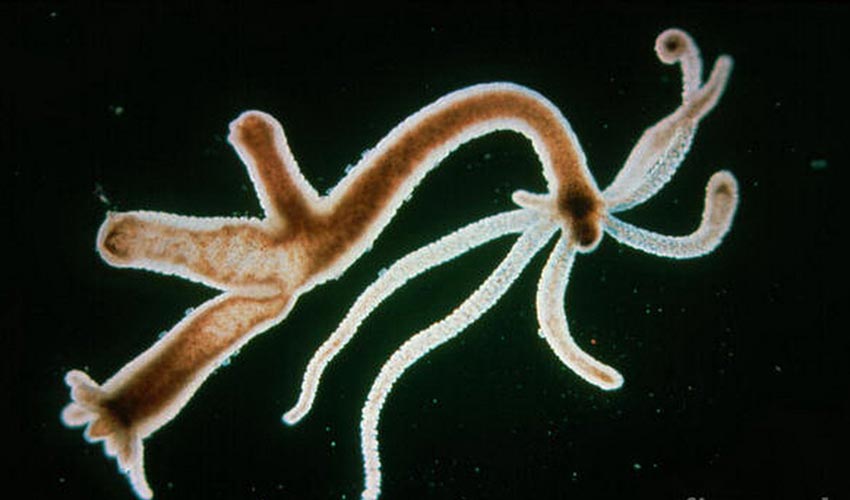
This incredible creature serves as a testament to the eternal cycle of life and death, a reminder that even the most fragile beings possess a power to endure and thrive. The Hydra's ability to not only regenerate but also to resist the effects of ageing, is a true marvel of the natural world. Biologist Daniel Martinez's eye-opening study in 1998 revealed that mature Hydra specimens showed no signs of ageing over a period of four years of observation. Subsequent studies, spanning a total of 8 years, confirmed this incredible finding: the Hydra does not age. Martinez, originally seeking to prove the creature's susceptibility to ageing, was instead met with undeniable evidence of the Hydra's age-defying capabilities. In a world where time affects all living beings, the Hydra stands out as an anomaly, a living testament to the mysteries and miracles of the natural world. Its ability to regenerate and resist ageing serves as a constant reminder of the endless possibilities and potential found within the realm of nature. The Hydra truly is a marvel, a symbol of strength, resilience, and the enduring power of life itself.
Are Hydras truly immortal creatures? Despite popular belief, the answer is a resounding no. On average, 167 of these fascinating organisms meet their end every year, regardless of their age. While some may think that an individual Hydra can live indefinitely under perfect conditions, the reality is far less glamorous. In a controlled experiment, these creatures were provided with a comfortable environment - a private dish with ample food and water. However, life in the wild is not always so idyllic. Just like the mythical Hydra of ancient lore, which was eventually vanquished by Heracles, biological Hydras too can succumb to mortality.
The Immortality of Hydra Cells – Stem Cells
So what is the secret behind the immortality of Hydra cells? One possible explanation lies in the presence of stem cells. Unlike regular cells, stem cells possess the unique ability to transform into different types of cells as needed. Think of them as raw materials waiting to be shaped into whatever form the body requires. Humans also have stem cells, with our embryonic stem cells once serving as the building blocks of our earliest existence. As these cells specialised and lost their versatility, they ultimately contributed to the formation of the person we are today. In essence, stem cells hold the key to both the longevity and adaptability of life forms like the Hydra.
Adult stem cells may not be as versatile as embryonic ones, but they possess a remarkable ability to adapt to the needs of the tissues where they reside. For instance, endothelial stem cells found in bone marrow have the potential to differentiate into various cell types that line blood vessels, contributing to the health of the cardiovascular system. Stem cell populations are also present in other parts of the body, such as the breast tissue, nasal lining, hair follicles, and even the brain. However, as we age, the regenerative capacity of our stem cells diminishes, making it more difficult for them to replace damaged or dysfunctional cells. This is where Hydra, a tiny aquatic creature, stands out. Hydra stem cells possess an extraordinary quality - they retain their potency indefinitely, earning them the moniker of the "eternal embryo". Researchers are eager to uncover the secrets behind Hydra's seemingly eternal youth, as understanding these mechanisms could potentially unlock the key to immortality for humans. The prospect of harnessing Hydra-like regenerative abilities has sparked considerable interest and excitement in the scientific community. If scientists can unravel the mystery of how Hydra's stem cells maintain their vitality, it may pave the way for spectacular advancements in regenerative medicine and potentially offer a path to eternal life for humanity. Truly amazing! Don’t you think?
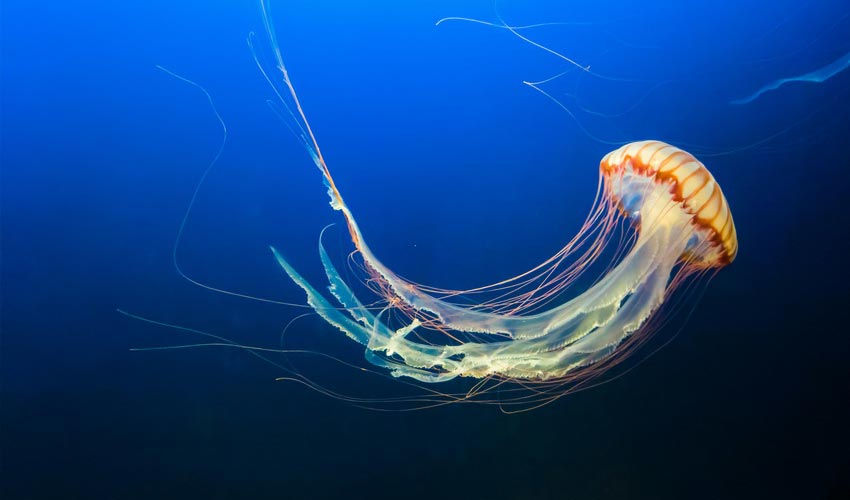
Regeneration
The legend of Prometheus and his regenerating liver may sound like a myth, but there is indeed truth to the idea that our bodies have the power to regenerate certain damaged body parts. While we may not be able to regrow limbs like some animals can, our bodies possess the ability to heal and repair themselves in remarkable ways. For example, if you damage your liver with excessive alcohol consumption, it has the remarkable ability to regrow itself given the opportunity. If you suffer a burn, your skin can regenerate and recover from the injury. Even something as simple as losing a fingernail can be remedied by your body growing a new one. But why stop there? If we can regenerate tissue like bones and skin, why not take it a step further and regenerate more complex body parts like limbs? One theory is that the powerful stem cells responsible for regeneration need to be carefully controlled to prevent the risk of cancer. If these cells were to grow unchecked, it could lead to dangerous consequences.
Enter regenerative medicine, a cutting-edge field of science that seeks to harness the power of stem cells to regenerate and repair damaged tissues. By stimulating these cells, either on their own or with the help of donated tissue, researchers hope to unlock the full potential of the body's natural healing capabilities. Plants may serve as a fascinating example of the regenerative potential that exists in nature. They can regrow virtually any part that is cut off, effortlessly and automatically. Even plants can suffer from cancer, but their simpler biology allows them to contain the disease and continue to regenerate without major consequences. The idea of regenerating body parts may seem like science fiction, but with advancements in regenerative medicine, it may soon become a reality. By understanding and harnessing the power of our body's own regenerative abilities, we may one day unlock the potential to heal and repair damaged tissues in ways we never thought possible.
The Jellyfish
The jellyfish wriggles desperately, its translucent body pulsating with panic as it tries to evade the hungry jaws of the Loggerhead turtle. One wrong move and it could be the end of this delicate creature. With a surge of determination, it propels itself forward, pushing through the thick seaweed in a frantic bid for safety. Barely escaping the snapping jaws, the jellyfish burrows deeper into the shadowy depths, seeking refuge from its relentless predator. Finally, it finds a small crevice beneath the gentle swaying leaves of the seaweed, a temporary sanctuary in the vast expanse of the ocean. But the respite is short-lived as the jellyfish discovers a grim reality - nearly half of its tentacles are missing, devoured by the hungry turtle. With only a fraction of its tentacles remaining, the jellyfish faces a dire situation. Its strength wanes as it struggles to swim and feed with limited resources. Desperate to survive, the jellyfish makes a drastic decision. In a last-ditch effort to ensure its survival, it begins to disintegrate, its body slowly shrinking and sinking to the ocean floor. But this is not the end for the injured jellyfish. In a remarkable display of resilience, its disintegrating body transforms into a colony of polyps, each one a genetic copy of the original jellyfish. These polyps bud and release medusae, offspring that are identical to their parent in every way. Through adversity and sacrifice, the jellyfish has found a way to ensure its legacy lives on. As the medusae drift away into the vast ocean, the cycle of life continues, a testament to the incredible resilience and adaptability of these mysterious creatures of the sea.
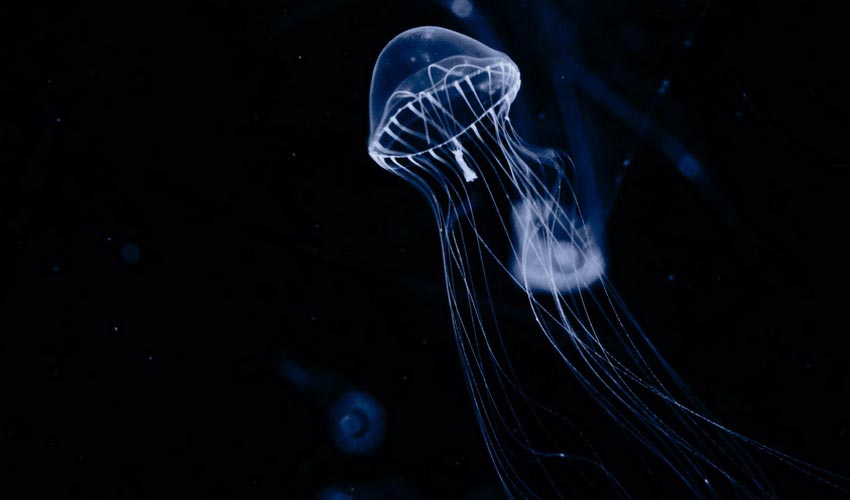
In 1991, NASA embarked on a ground-breaking mission that included 2,478 jellyfish as its unexpected passengers. These unique creatures were not just along for the ride, but were part of a fascinating experiment to explore their relationship to gravity and how it compared to that of humans. The ultimate goal was to gain insight into how jellyfish born in space would adapt, providing valuable information on how humans might fare in such an environment. What unfolded during the course of the experiment was truly intriguing. The Earth-born jellyfish faced challenges as they experienced hormonal changes and struggled to orient themselves in the weightless environment, unsure of which way was up. On the other hand, the space-born jellyfish encountered their own set of obstacles upon returning to Earth, displaying a passive and inert behaviour due to their confusion with gravity. Interestingly, this passive behaviour exhibited by the space-born jellyfish could actually be seen as a positive outcome. It hinted at the remarkable ability of these creatures to adapt from being Earth-born to space-born in just one generation. The implications of this adaptability are profound, suggesting that perhaps jellyfish can teach us valuable lessons about the potential for immortality and adaptation in the face of challenging environments. The fact that NASA chose jellyfish for this experiment speaks volumes about the underlying similarities between these seemingly unrelated creatures and humans. It raises thought-provoking questions about the interconnectedness of all living beings and the potential for shared lessons across species. In exploring the mysteries of gravity and immortality through the lens of jellyfish, we may uncover deeper truths about our place in the universe and the boundless possibilities that lie ahead.
The Immortal Jellyfish (Turritopsis dohrnii) – Our Planet’s Longest-Living Species
While humans marvel at their ability to regenerate tissue and Hydra astonish with their ability to regenerate their entire bodies, the jellyfish takes regeneration to a whole new level. Meet Turritopsis dohrnii, also known as the immortal jellyfish, a creature that can transform from an adult back into a baby countless times. This remarkable feat is made possible in part because jellyfish lack a brain, bones, eyes, or even a heart, simplifying the complexity of their bodies and making self-repair and self-regeneration a seamless process. It's almost as if evolution took a cue from Marie Kondo, creating a minimalist creature that "just works." With a rudimentary digestive system consisting of just one multipurpose opening that acts as a mouth, garbage chute, and propulsion vent, digestion occurs rapidly, allowing the jellyfish to effortlessly float through the water. Without a brain to centralise decision-making, power is distributed throughout various parts of the jellyfish's body. Take stinging, for example, one of the fastest processes in biology. Sub-cellular harpoons shoot out at incredible speeds, capable of piercing a crustacean shell or delivering a deadly dose of poison. But here's the catch - stinging is not a conscious decision made by the jellyfish. When a tentacle comes into contact with something, stinging automatically occurs. Even a dead jellyfish tentacle or a half-digested jellyfish inside a squid can still deliver a nasty sting. The marvel of the immortal jellyfish lies not only in its ability to constantly rejuvenate itself but also in its fascinatingly simple yet effective design. A true testament to the wonders of nature's ingenuity!
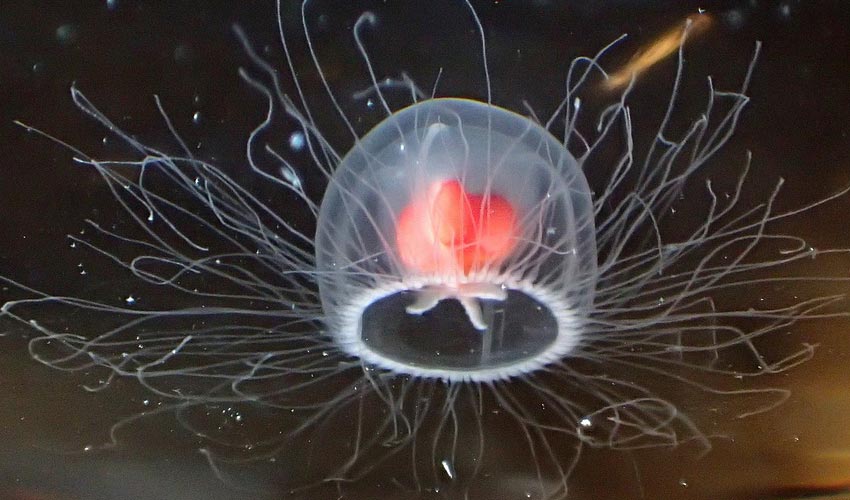
The discovery of the immortal jellyfish in the sparkling waters of the Mediterranean Sea in 1883 sent shockwaves through the scientific community. However, its true marvel was not unveiled until the 1990s. This mysterious creature, known as Turritopsis dohrnii, possesses a remarkable ability that sets it apart from all other beings on earth. Typically, the immortal jellyfish reproduces asexually and follows the natural course of life, eventually succumbing to old age and perishing. But when faced with a threat to its existence, such as starvation or physical harm, this extraordinary creature defies the laws of nature. Its entire body regresses to its earliest form, the polyp stage, where each and every one of its cells is rejuvenated. Adult cells miraculously transform into specialised cells for various tissues, allowing the jellyfish to essentially start its life anew, sinking to the ocean floor to begin the cycle once more. The concept of regeneration is something that humans can only dream of. The intricate process of rebuilding an entire body, including complex structures like a skeleton, digestive tract, and even a brain, remains beyond the realm of human capability. If individuals wish to explore the realms of rebirth, reincarnation, and past lives, they must seek alternative means. Even the immortal jellyfish itself does not possess the power to cheat death at will. Its remarkable abilities are only activated in times of crisis, when its survival is at stake. Despite its remarkable skill in regeneration, the immortal jellyfish remains susceptible to disease and predators, reminding us all that even the most extraordinary beings are not invincible. And as we ponder the ultimate question of identity, we are left to wonder: once the immortal jellyfish has transformed and rejuvenated, is it still the same creature it once was? The enigmatic nature of Turritopsis dohrnii continues to captivate and mystify, leaving us to marvel at the wonders of the natural world and the secrets that lie within.
''Our Creator would never have made such lovely days, and have given us the deep hearts to enjoy them, above and beyond all thought, unless we were meant to be immortal.'' - Nathaniel Hawthorne






















